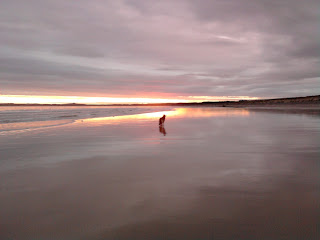We’ve told you how Cairid, in four homes before his first year, didn’t have the benefit of early socialisation with other dogs. He doesn’t see this as a disadvantage of course. It’s just us. It’s our aching shoulders, our frayed nerves, our disillusionment and impatience with fellow dog-walkers who don’t understand and don’t give a damn anyway. You see them look at you, while you fight to keep control of a strong dog who lunges on the end of a lead, with an expression of incredulity on their faces. They clearly say without words, “Why are you allowing this? Why are you not severely chastising this dog?”
It’s a long story, but in brief we’ve been working with Cairid the best ways we know how. We’ve tried everything available, as long as it doesn’t involve punishment which we know would make his insecurity with other dogs worse, and which we do not believe is ever effective in any case. But we are only human. Sometimes we get it wrong, or can’t be bothered to think about it. Other times we feel despair. No matter how much effort we put into it, nothing improves.
But – wait a MINUTE!! – today was major red letter day in our calendar! We’ve been using a clicker – first associating a click with getting a treat, then using it in the house and garden for easy things like “here” and “sit” and “lie down”. Then we started taking the clicker for walks with us. We do random recalls, but not too many so he doesn’t get bored with it. Cairid is on a long line during all our walking in the forest, but has off-lead spells on the beach where we can see if other dogs are approaching. When we see other dogs coming, we do a fairly large “curve” past the other dogs. The minute Cairid stops looking at them and trots back to us he gets a click and a treat. He may have lunged. That doesn’t matter. We ignore that. We just reward the coming back to us after seeing another dog. Cairid desperately wants to chase, play rough, and generally make himself a nuisance – probably not from most other dogs’ points of view, but certainly from their owners’. Our worse-case scenario is a small barking dog running. Cairid will chase till he catches it, and has been known to grab it by the leg, although not to its injury. Hence, no freedom around other dogs! Anyway – I digress! Let me tell you about this morning, bearing in mind this is MONTHS after we bought a clicker.
We’re walking along when suddenly around a bend comes a barking beagle, a confident retriever and a disinterested black lab, followed by their owners. We didn’t have time to curve, and besides, the retriever and the beagle were approaching fast, off lead. Dislocated shoulder time. A brief conversation with the owners led us to believe that they wouldn’t have minded if we’d let Cairid off for a play. We carried on, muttering. About an hour later we were on the beach, throwing a ball into the sea for Cairid. Along came the same three dogs and owners, and we clipped Cairid on his lead. Another brief conversation on the way past while we answered questions about Cairid, and we parted company on friendly terms. When we were well past we again released Cairid and threw the ball into the sea. Off he dived, throwing himself with great vigour over the waves. He’s swimming back with the ball, when suddenly we’re aware that the retriever has left his owners and come racing back towards us. Oh heck! Well, we could do nothing but watch. The retriever runs into the water to watch Cairid swim towards him. When they’re out of the water, the retriever bounces up and the two dogs are looking at each other (I wish we could have filmed it to see in slow motion.) then the retriever starts to run. He has his tail down, and Cairid chases him. Then the retriever stops and turns around and Cairid stops, as though he doesn’t quite know what to do next. At that point, we did a recall. And for the FIRST TIME EVER when there’s been another dog on the scene, he came back to us, and the retriever ran off without Cairid attached to his tail. You’re probably thinking SO WHAT? Well, it’s a breakthrough moment, that’s what! He can do it. He DID do it. And the chances are that he will do it again. Because he got the best treats ever and the most wonderful attention. And we love him. And we think these other dog owners are pretty cool too. Life is good. Sometimes.









